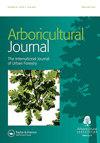Endocormic roots: transforming death into life
Q3 Agricultural and Biological Sciences
引用次数: 1
Abstract
ABSTRACT There is a substantial literature on the production of adventitious roots by the trunks and branches by intact trees but one type that has received very little attention are the endocormic roots that develop inside the trunks of old trees with extensive heart rot. They were first described in 1853 and are an indicator of the senescent phase of a tree’s life span. Endocormic roots are produced by wound-wood that comes in contact with its own rotten heartwood. As the tree’s core hollows out, endocormic roots can grow down through the trunk into the soil where they have the potential to produce a new root system and thicken into columns that support the hollow stem. While the formation of endocormic roots has been documented in many angiosperms, it is a relatively uncommon phenomenon that develops mainly in ancient trees that have experienced extensive branch loss due to natural disturbances or pollarding. A parallel term, epicormic roots, is proposed to describe adventitious roots produced by the trunk or branches of a tree that come in contact with the soil.内源性根:将死亡转化为生命
关于完整树木的树干和树枝产生不定根的文献很多,但有一种类型的不定根很少受到关注,即在具有广泛心脏腐烂的老树的树干内发育的内胚根。它们于1853年首次被描述,是树木寿命衰老阶段的一个指标。内源性根是由受伤的木材与自己腐烂的心材接触而产生的。随着树的核心掏空,内源性根可以通过树干向下生长到土壤中,在那里它们有可能产生新的根系,并加粗成柱来支撑中空的茎。虽然在许多被子植物中都有内胚根的形成,但这是一种相对罕见的现象,主要发生在由于自然干扰或授粉而经历大量树枝损失的古树中。一个平行的术语,外生根,被用来描述由树干或树枝与土壤接触而产生的不定根。
本文章由计算机程序翻译,如有差异,请以英文原文为准。
求助全文
约1分钟内获得全文
求助全文
来源期刊

Arboricultural Journal
Agricultural and Biological Sciences-Agronomy and Crop Science
CiteScore
2.40
自引率
0.00%
发文量
28
期刊介绍:
The Arboricultural Journal is published and issued free to members* of the Arboricultural Association. It contains valuable technical, research and scientific information about all aspects of arboriculture.
 求助内容:
求助内容: 应助结果提醒方式:
应助结果提醒方式:


